- South America
- A Glimpse Inside San Pedro...

A Glimpse Inside San Pedro: Bolivia’s Self-Run Prison

Right in the heart of La Paz’ middle class San Pedro neighborhood lies one of the world’s most notorious prisons. Cárcel de San Pedro (San Pedro Prison) reached international fame in 2003 when Australian law graduate Rusty Young released his first novel, Marching Powder : A True Story of Friendship, Cocaine, and South America’s Strangest Jail . The bestselling book captivated readers for its harrowing insight into the lawlessness and corruption inside the now-infamous jail. After all, this is a prison that is completely self-run, where police only patrol the perimeter to thwart potential escape efforts, leaving governance entirely in the hands of the criminals inside.
Three thousand inmates cram into the chaotic prison that was originally designed for just 600. They are not assigned rations or accommodation by the state, instead relying on the generosity of family members or income from menial jobs on the inside. There are a number of employment opportunities inside the jail, from bar tenders, chefs, waiters and shopkeepers, to security guards, politicians and real estate agents. Some years ago, there were even guided tours given inside the prison. Corrupt guards would allow English-speaking guides to escort foreign tourists through the complex, some of whom stayed overnight to enjoy wild, cocaine-fueled parties.

Much like life in the free world, society inside the prison is divided into classes depending on the economic wealth of the inmate. The poorest reside in notoriously dangerous sections which are crammed full of addicts sharing with up to five people in a cell designed for one. But the quality of accommodation increases dramatically for those with financial means, with the richest living in fancy, gated communities that are segregated from the rest. Many of these are corrupt businessmen, politicians or narco-traffickers who enjoy luxuries such as flat-screen TVs, wifi, or even Jacuzzis.

The prison also has a remarkably well-structured political system. Each section has its own administrative officials who oversee housing, security, punishment and sanitation arrangements. Their salaries come from funds raised by internal fees and taxes, which are managed by the prison treasurer. A prison mayor is democratically elected on an annual basis, and enjoys the highest authority in the community.

Due to a lack of police presence inside the facility, large-scale cocaine production is undertaken to bring much-needed income into the community. Huge, elaborate labs produce what is said to be the country’s finest cocaine, while smaller clandestine operations produce just enough to supply the prison’s many addicts. The good stuff is smuggled out daily through visiting family members, a practice casually referred to as negocios (business). Unsurprisingly, addiction is rife throughout the complex. The majority of users smoke base, leftover residue from the production process that is highly addictive. Eighty percent of inmates are inside for drug-related offences, and 75 percent are still awaiting trial.

Women are forced to live on the inside with their husbands as they can’t afford to support themselves alone. Many bring their children with them, who only leave once a day to attend a nearby school. Life on the inside leaves the women and children vulnerable to abuse, resulting in frequent occurrences of rape. The worst of which caused the death of a young child whose perpetrator was later caught and beaten to death in what is known as justicia comunitaria (community justice).

The Bolivian government has been planning the prison’s closure for years now due to overcrowding, rampant drug production and the inability to protect innocent family members from abuse. It also happens to occupy a large portion of prime inner-city real estate, undoubtedly worth significant money. Upon closure, most prisoners will be sent to Chonchocoro, a notoriously harsh and strictly controlled prison in the impoverished city of El Alto. Every time the issue is brought up the inmates riot in a desperate attempt to protect their homes and community. As bad as San Pedro may seem, living conditions for even the poorest residents are preferable to those of Chonchocoro.
Since you are here, we would like to share our vision for the future of travel - and the direction Culture Trip is moving in.
Culture Trip launched in 2011 with a simple yet passionate mission: to inspire people to go beyond their boundaries and experience what makes a place, its people and its culture special and meaningful — and this is still in our DNA today. We are proud that, for more than a decade, millions like you have trusted our award-winning recommendations by people who deeply understand what makes certain places and communities so special.
Increasingly we believe the world needs more meaningful, real-life connections between curious travellers keen to explore the world in a more responsible way. That is why we have intensively curated a collection of premium small-group trips as an invitation to meet and connect with new, like-minded people for once-in-a-lifetime experiences in three categories: Culture Trips, Rail Trips and Private Trips. Our Trips are suitable for both solo travelers, couples and friends who want to explore the world together.
Culture Trips are deeply immersive 5 to 16 days itineraries, that combine authentic local experiences, exciting activities and 4-5* accommodation to look forward to at the end of each day. Our Rail Trips are our most planet-friendly itineraries that invite you to take the scenic route, relax whilst getting under the skin of a destination. Our Private Trips are fully tailored itineraries, curated by our Travel Experts specifically for you, your friends or your family.
We know that many of you worry about the environmental impact of travel and are looking for ways of expanding horizons in ways that do minimal harm - and may even bring benefits. We are committed to go as far as possible in curating our trips with care for the planet. That is why all of our trips are flightless in destination, fully carbon offset - and we have ambitious plans to be net zero in the very near future.

See & Do
The top things to do and see in la paz, bolivia.

Restaurants
The best restaurants in la paz, bolivia.

The Best Contemporary Art Galleries In La Paz

A Foodies’ Guide to La Paz, Bolivia

Bars & Cafes
The best bars in la paz, bolivia.

Places to Stay
The best hotels in la paz, bolivia, for every traveler.

Food & Drink
The best cafes in la paz, bolivia.

The Best Vegetarian and Vegan Restaurants in La Paz

Where to Stay on a Budget in La Paz, Bolivia

Why This Clock in La Paz Runs Backwards

Guides & Tips
La paz vs santa cruz: which city is for you.

The Best Museums and Galleries in La Paz, Bolivia
Culture trip spring sale, save up to $1,100 on our unique small-group trips limited spots..

- Post ID: 1165937
- Sponsored? No
- View Payload

San Pedro – A Prison Like No Other
La paz - bolivia.
On a Sunday afternoon in La Paz, I went to prison.
No, they didn’t arrest me for drugs or acts of public indecency, rather it was a straight-forward tourist thing.
You see, there’s a guy Fernando, English speaking, who’s been in the slammer for 4 years now – on an 8 year sentence – for possessing only 4 grams of cocaine.
Yet, he admits he’s been a drug dealer all his adult life.
And now, he’s organizing San Pedro prison tours – with the help of the jail governor, who he bribes with tourist dollars.
So far, he’s shortened the last 4 years to 1.5 with his prison tours
Touring San Pedro Prison is to enter a brutal surreal circus
Despite once being a nunnery of – I assume, well-behaved, Catholic virgins, the complex now houses 1300 of the baddest bad boys.
Resembling a shanty market, but with high walls and deep courtyards, survival in San Pedro depends on your cash and insider status.

Fernando lived in the elite ghetto of corrupt lawyers, mafia and drug barons busted.
They had cells—more like hostel rooms—around a cluster of balconies, furnished with TVs, waterbeds, computers. All luxuries paid thru the system.
The richest guy in the prison was a mafia boss busted with 4 tons of coke, and he lived on the ‘penthouse’ top floor.
We’d waited at the prison’s stone-fort entrance, then passed thru a metal detector and armed guards.
Past lines of families. Guards searched Bolivian women with black plaited hair and traditional bowler hats. I show ID.
Walking thru locked iron gates. Meantime a guy behind bars shouts instructions on ‘How to Enter the Prison’.
Inside and surrounded by half a dozen of ‘his security boys’, I paid the guard’s fee.
Then ushered into another courtyard to begin the prison tour.
- No photos allowed
For an hour, they showed us around block to block, protected by an alert group of tough guys.
It wasn’t a prison movie setting of concrete-block rows, cells and bars.
Rather, a maze of rooms and alleys and balconies and courtyards – some with food kiosks, fruit and veg stalls. Others had card games going-on and shoe repairs as small business was the key to survival inside.
I watched men talking with families, laughing with girlfriends, and kids wandering.
Many families stayed inside with their dads, kids went to school to return each night to prison!
Prisoners have to rent rooms in San Pedro Prison
Often they had to keep their families here, rather than kids living on the street.
New prison arrivals who had no money became the servant of someone else in exchange for a floor to sleep.

Food was free.
Yet moneyed prisoners never ate it because it had sedatives. (I watched zombies wait in line to eat.)
Instead, most prisoners cooked or ate at kiosks, run by as inmate businesses.
Prisoners ran San Pedro Jail; not the guards
No guards dared to enter inside, they only patrolled the streets and the walls outside.
Everything was available.
Alongside food and standard commodities, there was alcohol, cocaine, grass. And women! Wives, pros, girlfriends could enter and stay overnight, for a price.
The 1-hour tour of San Pedro Prison cost $10
An overnight – your-own-cell, sex and substance package started at $100.
But – No. Too much potential for problems.
So why could this guy operate a prison tour?
Well, he was number 7 in the hierarchy of 8 who ran San Pedro Prison. And one of his friends, who accompanied us, was the number one guy.
A mafia mean-looker who handled punishments. He took special interest in dealing with convicted rapists.
They outlined their torture methods.
Do you want to hear about it? Probably not.
Anyway, these guys got everything they needed.
Plus, time off their sentences for doing this prison tour as the Governor got rich.
Both men had long scars down the throats and face.
I felt safe here.
But when family visiting hours were over, “accidents and suicides”—as he put it—often happened, often; sometimes weekly, especially over gambling debts.
Back to punishments: When a new rapist arrived in prison, they forced him into a concrete pool in the courtyard. There he would get abuse. Have food, shit, piss thrown over him. Later beaten across the bare butt 20 to 30 times with a plastic-coated lead cable (torn from prison walls). Most rapists screamed for mercy after 3 lashes. Following the lashings came crushed, hot chillies rammed up his bleeding butt.
And on that note, my San Pedro Prison tour ended – the glee of the torturer smacking this rod against a wall.
Wack! Wack! Wack!

My 2002 experience was before the book Marching Powder (about Thomas McFadden, an imprisoned English guy who began these tours in San Pedro; written by Rusty Young). But by 2009, they stopped these tours after a riot inside the prison ended in swat teams and tear-gas.

Comment Link: San Pedro Prison riots that closed down the tours
Travels in Bolivia – 2002
Join the Journey
Get my FREE book of Crazy Travels & occasional updates
Check your inbox or spam folder to confirm your subscription.
Add a Picture/Graphic Caption (optional)
Click here to upload more images (optional)
Author Information (optional)
To receive credit as the author, enter your information below.
Submit Your Contribution
- Check box to agree to these submission guidelines .
- I am at least 16 years of age.
- I understand and accept the privacy policy .
- I understand that you will display my submission on your website.
(You can preview and edit on the next page)
Vea otros mensajes. See other messages:
Click here to write your own.
Bolivia Travel Forums | Tourism | Live in Bolivia | Plan Your Trip
BoliviaBella.com is not a political forum and does not promote nor endorse specific political views on this site. Any views shared by our readers through the various forum pages available on the site are absolutely the responsibility of their authors.
BoliviaBella.com no es un foro político y no promueve ni endosa puntos de vista políticos específicos en este portal. Todas las opiniones compartidas por nuestros lectores mediante los foros disponibles en el portal son de la responsabilidad de sus autores.

Would you prefer to share this page with others by linking to it?
- Click on the HTML link code below.
- Copy and paste it, adding a note of your own, into your blog, a Web page, forums, a blog comment, your Facebook account, or anywhere that someone would find this page valuable.
- Exhibitions
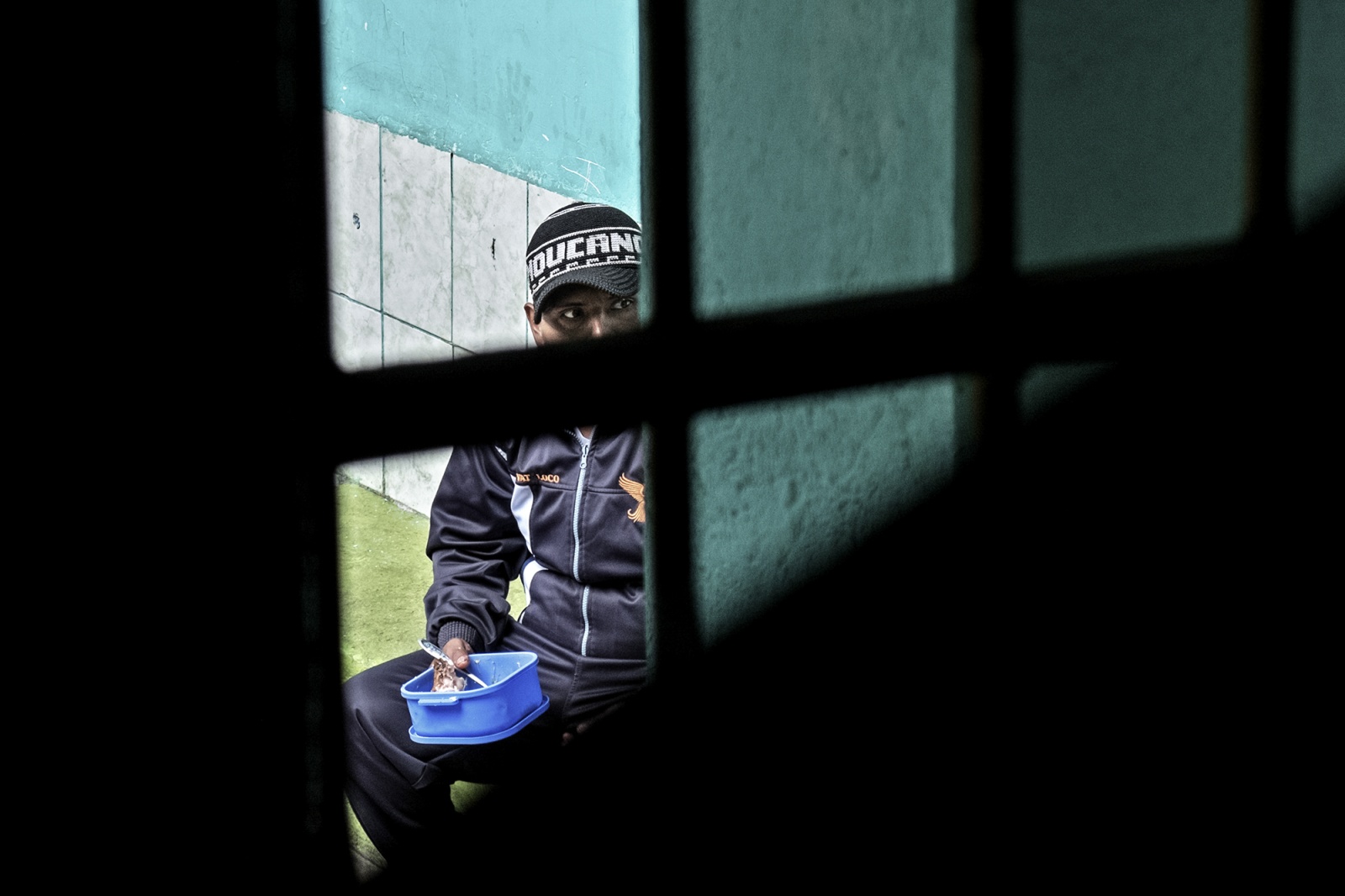
San Pedro Jail: the Prisoners town in the heart of La Paz
- Login / Register
- You are here: Essays
A law unto themselves: San Pedro prison in La Paz, Bolivia
15 June 2018 By Rusty Young Essays
The thriving sense of community at San Pedro prison in La Paz, Bolivia, belies the dangers to which inmate families are exposed
This is one of the most read articles on the AR website. If you enjoy reading the AR online, why not consider subscribing to the print edition?
Welcome to San Pedro – the strangest prison on the planet. In the centre of La Paz, it occupies an entire city block and fronts onto a picturesque plaza. From the outside, everything seems normal enough. Looking around the leafy plaza you see colourfully dressed indigenous women in bowler hats standing by carts, squeezing orange juice, and old men seated on benches, feeding pigeons. At the prison entrance, idle policemen in green uniforms lean against the 15-metre-high yellow wall. It’s only once through the heavy iron gates that the craziness begins. Inside, the sights that greet you belong to a typical Bolivian street scene. Men mill about, exchanging pleasantries. Women carry sacks of food or roast meat on gas stoves. Small girls are laughing and playing hopscotch. Young boys are shining shoes. Listless cats and mangy dogs sleep beneath tables. Walls are emblazoned with the Coca-Cola logo. No one is wearing a uniform. And there is not a single guard in sight. Is this really a men’s jail?
A stroll through a maze of corridors reveals churches, market stalls and restaurants. Climbing up rickety wooden staircases you see small businesses, handicraft workshops, classrooms, a gym and a billiard hall. There’s even a football field and childcare centre. More like a city within a city than a prison, why does this place exist?

Panoptico san pedro paz izquierda lrzima20130727 0065 4
Execution of Bolivian revolutionary Martin Lanza in the Plaza de San Pedro in 1905
In 1850, blueprints for San Pedro were drawn up following an architectural competition. Due to lack of funds, however, the winning design wasn’t constructed until 1895. It was meant to house 250 inmates. These days it holds up to 2,000 men, most convicted as part of the ‘war on drugs’. This has caused extreme overcrowding with no change to the underlying problem: a lack of funds.
Bolivia is the poorest country in South America. Its government and police are notoriously corrupt. In most national prisons, inmates receive little more than a bowl of watery soup a day. So San Pedro inmates run the prison themselves, functioning as an independent community. They have developed rules, a political system and punishments, as well as a highly sophisticated economy.
As far as prisons go, San Pedro is like a hotel. Its central location makes family visiting easy. Being a minimum-security facility, conditions are far more lax than other ‘US-style’ prisons such as Chonchocoro. So places in San Pedro are in high demand.

6490144693 08987b232b o
Inmates run the prison, which functions as an independent community with its own rules and punishments. Photograph courtesy of Danielle Pereira / Flickr

Gettyimages 73938760
The prison even has a childcare centre within its walls. Photograph courtesy of Melanie Stetson Freeman / The Christian Science Monitor via Getty Images
New inmates are required to purchase their own cells, to which they are given the key. A price in US dollars is negotiated with an outgoing inmate. The pair sign a sale-purchase agreement, and afterwards an official property title deed is drawn up.
No two cells are the same. Prices vary according to size, quality and location. The eight sections, which resemble small suburbs, are ranked according to a hotel-style rating system. In the five-star section, wealthy inmates live in spacious, carpeted, furnished rooms, complete with en-suite bathrooms and views over the city. These ‘cells’ resemble luxury apartments and purchase prices can go as high as US$30,000. By contrast, in the filthy one-star sections, as many as five men are crammed in tiny hovels known as ‘coffins’, which cost only a few hundred dollars.
The extremely wealthy can even renovate their cells, or construct new ones. Bolivia’s most infamous trafficker, known as ‘Red Beard’, who’d been caught with 4.2 tonnes of cocaine in his own aeroplane, wasn’t happy with the size of his cell. So he built a second storey. He also had cable television installed. A politician I met in the upscale section had a formidable library and a jacuzzi in his rooms.
‘San Pedro inmates run the prison themselves, functioning as an independent community. They have developed rules, a political system and punishments, as well as a highly sophisticated economy’
If you can’t afford to buy, you can rent. In fact, wealthy inmates often buy up ‘properties’ as investments. Finally, at the end of their ‘stay’, they are presented with a bill for the water and electricity they’ve consumed. This might all seem like a fun game of Monopoly, if it weren’t so deadly serious. At 3,600 metres above sea level, La Paz is one of the highest cities in the world. At night, temperatures drop rapidly and you don’t want to be without a cell. This has led many prisoners to die of exposure.
It’s not just accommodation that inmates have to pay for, but also food, clothing and medicine. As a result, they need jobs to survive. These range from running errands, shining shoes, selling phone cards, washing laundry, waiting tables, and running small businesses, to selling handicrafts.

Gettyimages 73938702
Cells are as cramped or as spacious as personal finances allow. No two cells are the same. Photograph courtesy of Melanie Stetson Freeman / The Christian Science Monitor via Getty Images
As a concession to the inmates’ hardship, the government allows their wives, girlfriends and children (some 2,103 children according to a recent government survey) to live inside the prison. Each morning, swarms of children head out in uniform with backpacks to attend school. In the afternoon, they return to their fathers’ cells to do homework. The government claims this is a progressive policy, as inmates don’t lose contact with society or family. Having to work and being responsible for their own behaviour assists rehabilitation, making them less likely to later re-offend. San Pedro is not unique in this respect. Prisons throughout Bolivia and in some other South American countries allow family to live inside. Obrajes women-only prison, in southern La Paz, is a successful model with strong discipline, little violence and strong cohesion between inmates.
But what about the children and women? They’ve committed no wrong, and yet live similarly to convicted criminals. Aren’t they in danger? Most prisoners treat the women and children with great respect. If a child walks past when two inmates are fighting, bystanders will call out ‘ Ñiño !’ (meaning ‘child’). The fighters will stop and hold their positions until the child has passed, at which point they resume fighting.

Spectators football1
Inmates and their children at San Pedro enjoy a football match. Photograph by Rusty Young

Eyevine2.00199845
Those in the more expensive cells have their own cable television, while the poorer inmates have to settle for communal timetabled viewings. Photograph courtesy of Toby Binder / Anzenberger / Eyevine
Nevertheless, shielding children doesn’t eliminate all dangers. Drug use is rife in San Pedro. Bolivia is the world’s third biggest cocaine producer and most inmates are in for drug offences – smuggling, trafficking and manufacturing. Once inside, they have the skills and contacts to continue their trade. As a result, the cocaine is cheaper and purer inside the prison than anywhere in the world. Hundreds of inmates are addicted to cocaine, which makes them violent and unpredictable. Stabbings are a frequent occurrence. Such an environment is no place for a child to grow up, so the Don’t Imprison My Childhood campaign sought to have the children removed. But the prisoners revolted and the children were allowed to stay.
‘On and off over the past two decades, enterprising English-speaking inmates have conducted tours of San Pedro. Tourists can buy handicrafts, sample the local cuisine at restaurants, or simply chat with inmates and their families’
It’s a complex dilemma with no easy solution. On the one hand, the prisoners are happy, the families stay together, and these children might be far worse off outside, perhaps living on the streets. On the other hand, they’re mingling with drug addicts and murderers. Or, worryingly, sex offenders, for which prisoners have developed their own protective system. Anyone suspected of sex offences is beaten, whipped with electrical cable, electrocuted, stomped on and then drowned in la piscina – a 2-metre-deep ‘swimming pool’. Rough justice indeed. But the alternative is equally deplorable.
In a shocking case that garnered world headlines in 2013, a 12-year-old girl in San Pedro was found to be pregnant. Authorities believed she’d been systematically raped over a five-year period by her father and uncle. The Prisons Minister promised to close San Pedro within three months.

Eyevine2.00199861
Prisoners experience a much more convivial atmosphere at San Pedro than would generally be the case. Photograph courtesy of Toby Binder / Anzenberger / Eyevine
Women and children are not the only unusual visitors. On and off over the past two decades, enterprising English-speaking inmates have conducted tours of San Pedro. They were started by Thomas McFadden, an African-born British inmate caught attempting to smuggle 5 kilograms of cocaine through the airport. Penniless and unable to speak Spanish, McFadden stumbled on the lucrative idea of charging backpackers to visit him. Tourists would pay US$5, then leave their passports with guards as collateral, before wandering the labyrinth of corridors for an hour, accompanied by McFadden and his bodyguards.
Tourists could buy handicrafts, sample the local cuisine at restaurants, or simply chat with inmates and their families. They often brought in much-needed clothing, food and medical supplies for the poorer inmates. For an additional $5, braver tourists could even stay overnight.
‘With every newspaper scandal locals shake their heads and roll their eyes, in a mixture of disgust and bemusement. To them, San Pedro is like a tragic soap opera, stuck on repeat, unlikely to ever change. And they’re probably right’
Many backpackers commented that San Pedro was cheaper than a hostel. Add in alcohol and pure cocaine, and McFadden’s parties could last for days. The year’s rowdiest celebration is the infamous Prisoners’ Day Party, which happens every September. Each section hires a rock group that belts out Bolivian ballads, while pretty girls in skimpy clothes parade around on stages.
At the peak of McFadden’s tours, up to 70 tourists would venture through per day. San Pedro became so popular that it was described in the Lonely Planet guidebook as ‘the world’s most bizarre tourist attraction’. The government denied that these ‘illegal tours’ occurred. However, following media exposés and tourist videos on the internet, they had to officially ban the tours and crack down on the drugs and corruption.

Everyday life in the prison, described by Lonely Planet as ‘the world’s most bizarre tourist attraction’. Photograph courtesy of Toby Binder / Anzenberger / Eyevine
With every newspaper scandal – cocaine sales, prostitution, prison tourism, murders, police criminality and child rape – locals shake their heads and roll their eyes, in a mixture of disgust and bemusement. To them, San Pedro is like a tragic soap opera, stuck on repeat, unlikely to ever change. And they’re probably right.
Five years after the young girl’s rape, San Pedro is still open. It’s business as usual. Cocaine is still available. The tours have simply moved outside. Each day in the plaza, hundreds of tourists stop to gawp and take ‘selfies’ in front of the main gates as part of a ‘City Walking Tour’. From time to time, a few lucky ones manage to slip past the corrupt guards and spend a few hours, or even a night, inside.
Leading image: A city within a city. Lives within the walls are not vastly different from those in the outside world. Image courtesy of Wikimapia.
This piece is featured in the AR’s June 2018 issue on Power and Justice – click here to purchase a copy .

Since 1896, The Architectural Review has scoured the globe for architecture that challenges and inspires. Buildings old and new are chosen as prisms through which arguments and broader narratives are constructed. In their fearless storytelling, independent critical voices explore the forces that shape the homes, cities and places we inhabit.

Join the conversation online

MyFunkyTravel
Backpacking | Budget Travel | Living Abroad
The World’s Weirdest Tourist Attraction: San Pedro Prison, La Paz
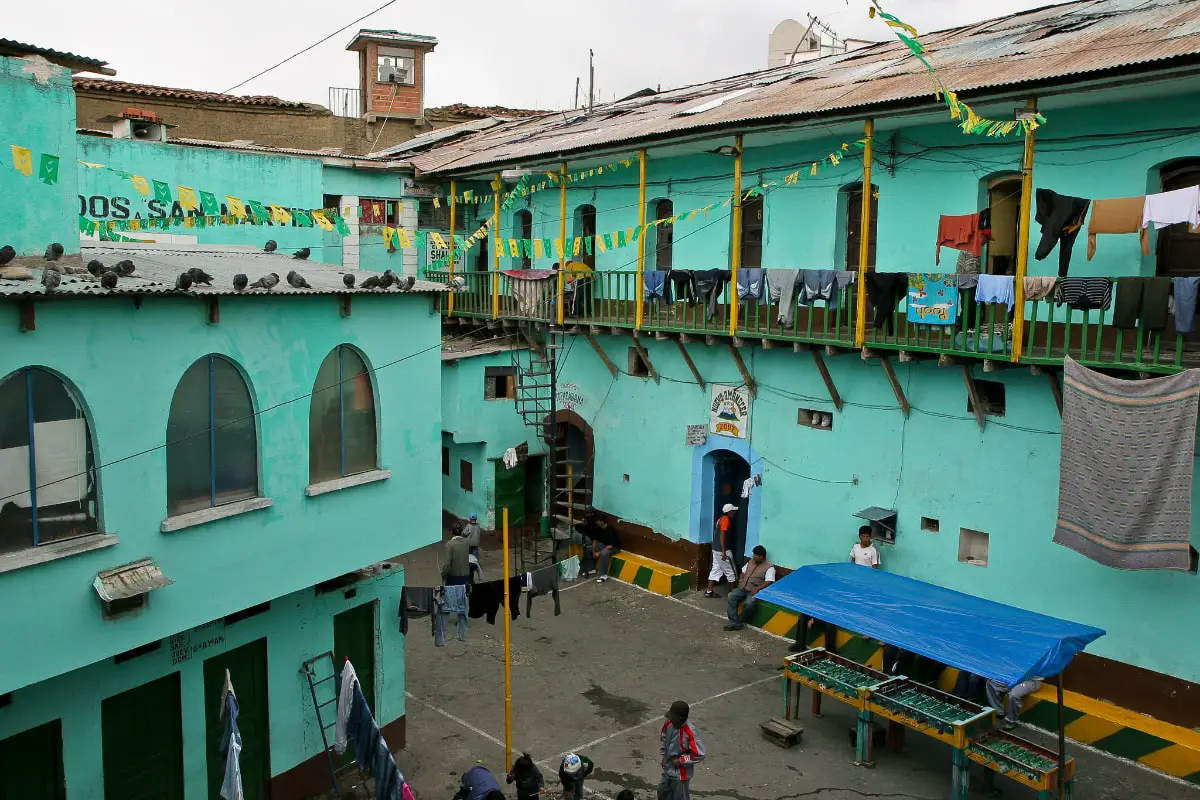
San Pedro Prison is one of the biggest in Bolivia and the common destination for people convicted of breaking the country’s laws. However this is no ordinary prison. San Pedro has gained an infamous reputation with all the bizarre stories that have come out of it through the years. This includes everything from tales of cocaine labs, wild parties and wealthier inmates renting fancy cells equipped with hot tubs and king-size beds. There was even a period when backpackers in La Paz would take tours of the prison and sometimes end up, quite voluntarily, staying for days or weeks in their crazy new surroundings.
Dark Tourism: Bolivia’s infamous San Pedro Prison
How does it differ from normal prisons.
There are all kinds of ways in which this place differs from a regular prison. Firstly, rather than being hidden away in some distant suburb or outside the city altogether, it is found right in the very heart of the administrative capital La Paz. Indeed El Penal de San Pedro overlooks a pleasant plaza of the same name, just a couple of blocks from Avenida 16 de Julio, the city’s main thoroughfare.
Inside, things only get weirder. San Pedro’s notoriety mostly comes in that it is one of the few prisons that is essentially run by its inmates. For starters, prisoners must pay for their cells when they enter the prison, that’s after they’ve coughed up the entrance fee!
Essentially, the prison has its own little, corrupt economy, and as in any other having a bit of money helps a lot. There are many different sections ranging from terrible conditions in the poorer parts where inmates are crammed in with up to 10 prisoners sharing a small cell to parts which are more like posh apartment blocks and house convicted businessmen and politicians.
The wives and children of many of the inmates also actually live with their husbands inside the prison. Every inmate must earn their living as nothing comes for free so many run shops, restaurants and, as has widely been reported, even cocaine laboratories. Unlike most prisons, guards rarely enter the main part of San Pedro, so prisoners are for the most part left to look after themselves. Unsurprisingly, there have been numerous tales of brutal violent acts between fellow inmates.
Thomas Mcfadden, Rusty Young & Marching Powder
Until the 1990’s, outside of Bolivia at least, little was known about the ongoings in San Pedro and travellers to La Paz came and went, most likely without even knowing the place existed. That all changed when British-Tanzanian Thomas Mcfadden started offering tours of the prison after he was incarcerated for drug trafficking in 1996.
Travellers passing through La Paz along the typical South America backpacking route (known as the Gringo Trail), quickly started to take notice and before long a visit to San Pedro, was high on the to-do lists of many adventurous travellers. Despite the apparent dangers of being a wealthy foreigner inside a prison in South America’s poorest country, many came back multiple times after the tours, to spend time with Thomas or enjoy the cocaine-fuelled parties.
One of those was Australian backpacker Rusty Young, a law graduate in his 20’s at the time, who went on to spend several months inside San Pedro, speaking to Thomas and writing a book about the place. Marching Powder , published in 2003, offers a fascinating insight into life in the prison through the eyes of Thomas Mcfadden and documents some of the crazier experiences he had. It’s an excellent read and still a popular companion for anyone travelling around South America.
Will there be a Marching Powder Movie?
There had been talk of a Marching Powder movie with plans seemingly gathering speed in 2014 when Brad Pitt’s Plan B Entertainment production company optioned the book and even got an actor in place to play Thomas Mcfadden. However as of 2021, there have been no further developments and there is still no movie.
There is though a 2017 film called Wildlands – a documentary by Marching Powder author Rusty Young on Bolivia and the brutal reality of the cocaine trade. This can be watched on Amazon Prime.
Backpackers in San Pedro
Thousands of backpackers have entered the prison since the tours first started, intrigued by what is unquestionably one of the oddest tourist attractions in the world. Given how lucrative and popular they had become, other inmates continued to offer tours, even after Mcfadden’s release, and they remained popular with travellers in La Paz throughout the 2000’s.
Even Lonely Planet at one point included San Pedro in its South America guides. Many visitors were shocked and fascinated in equal measure by the tour which normally included visits to the different sections, the cell of the guide and the infamous swimming pool where many inmates have reportedly been murdered.
Another draw for some travellers was the cheap cocaine on offer and that’s perhaps what the prison is most well known for. Many inmates are coke addicts and given that it is produced onsite, the cocaine in San Pedro is reportedly amongst the purest in the world.
What is San Pedro Prison like today?
San Pedro Prison today is much less accessible than it used to be when many of its darkest secrets would come out. That’s partly because the Bolivian authorities don’t like to admit the reality of the situation in San Pedro and its corrupt system, largely brought about by a lack of funds to properly police the place.
They are certainly against the kind of global publicity a potential Hollywood movie would bring, but word in La Paz is that the prison still operates in much the same way as it has done since the days of Thomas Mcfadden.
The impact of the global pandemic in 2020, means we don’t have any accurate recent reports of life in San Pedro. The above report comes from late 2019 and documents extreme overcrowding with the prison operating at over seven times its capacity. The going rate for a private cell/flat is now supposedly in the region of 1000USD/month, far beyond the means of most inmates.
Can you still do tours of San Pedro?
There are conflicting reports about the current situation with the tours over the past few years. Backpackers in San Pedro Prison are certainly a less common sight than 10 or 20 years ago but like many things in Bolivia, if you’ve got money and the contacts, you can make things happen.
However it is certainly harder to visit now than it used to be and there are wide reports of scams with people taking money off travellers at the gates and in the plaza. You also reportedly have to pay to get in and even more to get out so be very wary if you try to visit and do your research.
Your best bet is probably to talk to fellow travellers in South America and especially La Paz and try to go as a larger group if you are concerned about the safety of it. Hostel staff may also have up-to-date info but will most likely advise you against trying to go.
Alternatively, you can go to the plaza next to the prison where former inmate ‘Crazy Dave’ gives lively daily talks about his experiences inside (in English).
This article was last updated in January 2021
Featured Image of the Prison via Danielle Pereira , CC BY-SA 2.0
3 thoughts on “ The World’s Weirdest Tourist Attraction: San Pedro Prison, La Paz ”
Currently i’m living in that jail, i have the purpouse of make little tours in the future, say comments and sugestios
estas en la carcel?
I did the tour in late 2010, it was amazing. From memory (though it’s always subject to change) the tours only ran on weekends. If you were offered a tour during the week and coughed up the cash outside of the prison, you just got scammed. No $ are paid over until you are inside the prison in the guard’s offices. And yes there are cocaine labs inside, but (apparently, I wouldn’t know anything about this….) the drugs inside are no cheaper than the drugs outside the prison, so people don’t go there just to take drugs. But yeah sometimes they shut the tours down completely when new politicians or police chiefs come in, but once they manage to bribe them they start the tours up again.
Leave a Reply Cancel reply
Your email address will not be published. Required fields are marked *
Save my name, email, and website in this browser for the next time I comment.
Seeker is the social platform to find and share the places you love.
0 Places . 0 Trips and Guides.
Please enter your email
- Seeker for Brands
- Become a Brand Ambassador
- Let’s connect
New to Seeker? Join for free
Already have an account? Login
- South America
Can Tourists Still Party in San Pedro: Bolivia’s Most Famous Prison?
Sustainable travel expert, adventure seeker
Adelaide SA, Australia
Go to prison of your own free will. Have a massive party. Leave the next morning. Or stay. No one really cares.
A couple of years back, I spent 12 months wandering around South America , and from the day I landed, I quickly learned about the South American backpacker’s bible, and that it was basically required reading for anyone who had headed there in search of adventure.
Marching Powder tells the story of Thomas McFadden, a British man who was apprehended at Bolivia’s La Paz airport in 1996 with five kilos of cocaine hidden in his suitcase. It chronicles his experiences in San Pedro prison, an institution located right in the centre of the city.
This book is incredible , and I’d suggest reading it whether you’re a South American backpacker or not. As soon as I had worked my way through it, I was very intrigued to see how the prison described in the book compared to the prison of today, so I packed my bags —ensuring they were 100% powder free—and headed to La Paz. Here’s what I found.
It’s a weird place

So, you’ve been sentenced to a stay in San Pedro. The first thing you’ll be asked to do is pay the entry fee. Yep, like a day at Disneyland, you’ll need to pay for the pleasure of staying. Once inside, you won’t just be handed a cell, you’ll instead have to find a cell to rent. No money? You’ll be sleeping in the courtyard. Have a drug kingpin amount of money? You can rent a lovely two-storey condo with a Jacuzzi for around $5000 a month. Wild.
How do you pay your rent? By getting a job. Perhaps you become a realtor and rent out those cells. Perhaps you become a handyman, a cleaner, or a restaurateur (you can get a beautifully cooked fillet steak inside San Pedro if you’re willing to pay for it). Or perhaps, like a large percentage of the prison population, you turn your talents to producing cocaine. It’s common knowledge that San Pedro produces the highest quality cocaine in Bolivia, which sometimes leaves the prison by way of a diaper thrown over the wall.
But what if you’re a family man with a wife and kids in need of support? No problem, they can move in too . The kids leave the prison for school in the morning and come back at the end of the day while the wife finds an in-prison job, just like you.
Officially, San Pedro is a medium-security prison, but because of its unique economy and awesome location, it sees some very high-security type offenders buying their way in. This not only increases the amount of trouble, but the popularity also means that it holds around four times the amount of prisoners that it should.
You can’t go inside

In Marching Powder , McFadden earned money by leading guided tours through the prison. If the visitors paid enough, they were also allowed to stay the night and indulge in the jail’s famous “produce”. A lot of tourists go there today expecting the same situation, but, unsurprisingly, things have changed since the book was released in 2003.
When McFadden was released, there were other inmates, generally locals, who tried to keep the tours going. But after a series of unsavoury incidents–violence, sexual abuse, even instances where tourists were mistaken for real prisoners and locked up for weeks at a time–controls on outside visitors were tightened. Even if you are offered the opportunity to go in today, you just don’t do it.
You can get a firsthand account

With outside interest as great as it’s ever been, a new kind of tour has emerged to fill the void left by McFadden. And, while it’s certainly not the experience described in the book, I found it almost as weird.
If you’re in a La Paz hostel talking about going to San Pedro, someone will probably mention Crazy Dave. He’s a 50-something year old dude from New York who apparently got sentenced to 14 years after being busted smuggling 8.5 kilograms of cocaine. You may also hear of Alex, Crazy Dave’s Bolivian side-kick who spent some time in the US before being locked up in San Pedro for an armed robbery. He brought his family in with him.
If you head to Plaza Sucre around midday or 1pm, Crazy Dave and Alex, both of whom were still on parole when I was there, will manifest out of nowhere and ask whether you’re there for the tour. You don’t need to find them, they’ll find you . What follows is an hour long walking tour that takes place outside the prison walls, but offers amazing insight into what goes on inside. Crazy Dave plays the lead role, Alex is the hype man, and the whole double act is super entertaining.
The ex-cons confirm much of what was in the book and add in many of their own experiences, everything from drug production and parties to escapes and beatings. At the start of the tour, they promise to answer any question honestly and completely, and in my experience they were true to their word. It’s a truly fascinating, gritty, and entertaining tour.
Just watch for the powdered milk

And that’s not a euphemism. The oddest bit of the whole experience comes at the end. As a tip-based tour you give as much as you feel it was worth. I handed Alex a few Bolivianos, but as I turned to Crazy Dave he said “No, no, no. I’m a junkie, man. If I get cash, I’ll just spend it on drugs. If you don’t mind, I’ll take you to a supermarket and you can buy me some groceries.” How responsible , I thought to myself.
When we got to the supermarket, Crazy Dave marched down the aisle and grabbed two huge containers of powdered milk, along with a couple of little items, maybe a toothbrush and an apple. I asked him why he’s buying so much milk. “I bury it under a bridge, just in case I need emergency nutrition,” he says. The group then get the bill…double what any of us were planning to tip. But we pay–he’s an addict trying to come good, after all–and say our goodbyes.
But when we get back to the hostel we realise that everyone who has done the tour has bought the same thing for Crazy Dave: about 20 kilograms of powdered milk and little else. And this happens twice a day, almost every day of the week.
If you’re a person who likes their glass half full, you might suggest he has the world’s largest stomach and strongest bones. If you prefer your glass half empty, you might postulate that he’s cut a sweet deal with the supermarket to ring backpackers dry. Choose your own adventure, dudes.
But even with that knowledge in the bank, I’d still recommend the book, the visit, and the tour with every fibre of my being. Bolivia is a crazy country , and San Pedro is that craziness concentrated and distilled.
Even if it’s no longer like it was, it’s still a fascinating relic of a different time. And as the cogs of progress turn, it’s one that won’t be around forever.

You might like
5 things to do in bolivia to experience the real south america, 7 activities for the backpacking adrenaline junkie, is colombia safe for travel in 2023, 6 activities for an unreal day in huacachina, peru.
- Central America
6 of the Best Places to See Sloths in Central and South America
Festivals in latin america: the region's finest fiestas.
This story is over 5 years old.
Meet the man who thrived in bolivia's cocaine prison.
Thomas McFadden and Rusty Young in Bolivia's San Pedro prison (Photo by Simone Camilleri)

Get the latest from VICE News in your inbox. Sign up right here.
By signing up, you agree to the Terms of Use and Privacy Policy & to receive electronic communications from Vice Media Group, which may include marketing promotions, advertisements and sponsored content.
- Bars & Clubs
- Local Foods
- Restaurants
- Movies & Shows
- Museums & Churches
- Parks & Plazas
- Sport & Adventure
About La Paz
- Traditions & Holidays
- Transportation

Red Cap Walking Tour: La Paz Through a Local’s Eyes
Perched at a staggering 3600 metres above sea level, La Paz is a city unlike any other on earth. Having read such gripping travel tales of the frenetic city, I was eager to experience first hand what life was really like within the valley walls. Traveling to La Paz for the first time however, while impressed by the massive mountains and stunning views, I was surprised to discover just how congested and chaotic the sprawling city was.
To alleviate the stress of trying to navigate the complex and narrow alleys on my own, I jumped at the chance to explore La Paz with a guided tour.
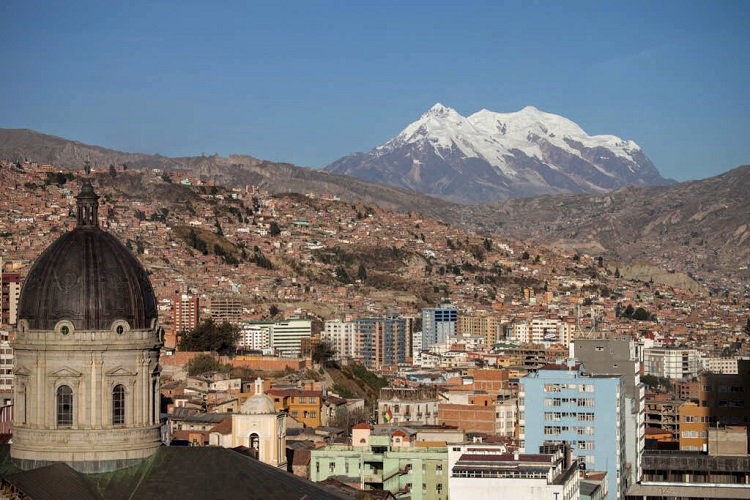
Experiencing Red Cap’s Walking Tour
As per Red Cap’s instructions I made my way to the meeting point. Upon arriving at Plaza San Pedro, I was quick to spot a red cap floating among a sea of about 30 tourists. After a friendly introduction from our two guides, and a quick meet & greet, we set off on our walking tour of La Paz.
San Pedro Prison
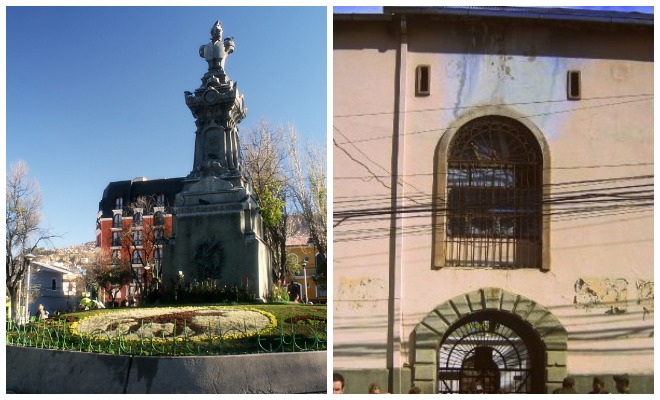
Located off the tranquil Plaza San Pedro, we were shocked to learn that some Bolivia’s most hardened criminals lived only meters away in one of the world’s most corrupt prisons.
What makes San Pedro prison so interesting are the conditions in which the 1500 or so prisoners live. A society within itself, the prison contains shops and restaurants run by inmates, women and children living voluntarily with imprisoned family members and ironically, some of the country’s busiest cocaine laboratories.
One of the most bizarre details we learned was that the prison runs its own economy. Not unlike ‘normal’ society, the more money prisoners have, the better their living situation. Corrupt politicians and drug lords live in luxury cells, while the poorest prisoners live in squalor. Inmates are also responsible for purchasing their own food and health care. A few prisoners are supported by family members, but many have to find jobs within the prison in order to survive.
For a deeper look into the infamous world of San Pedro Prison I recommend reading Marching Powder – it’s an interesting story to say the least!

Rodriguez Market
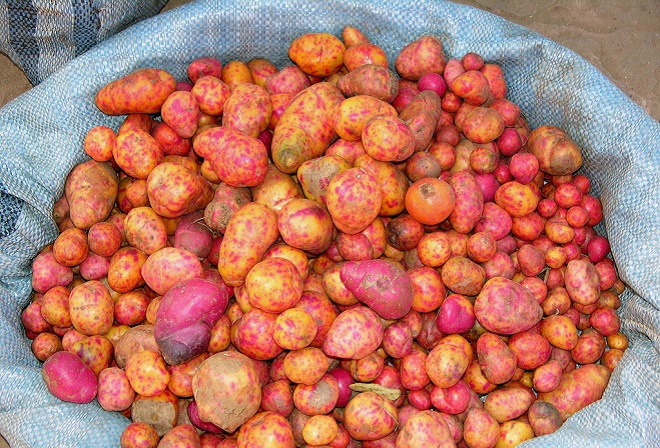
Our second stop was La Paz’s largest street food market, Mercado Rodriguez .
Before walking through the busy stalls selling fresh vegetables, fruits, meat and seafood, our guide explained to us the history of the potato in Bolivia.
Over 8000 years ago in the highlands Bolivia, the potato was first domesticated and has been the staple food for Bolivians ever since. The country boasts over 200 varieties of potato and it’s estimated Bolivians consume around 90kg of potatoes a year.
While walking through Rodriguez Market, our group was given the challenge to identify the 8 varieties of potato our guide described to us during the ‘potato lesson’. This was no easy task given there were spuds in literally every direction we looked.
One other thing that captured our attention at the markets were the colorful and elaborately designed clothing worn by the local women. Our guide briefly explained to us the history and components of Cholita Fashion and its significance to the Bolivian culture. It was bemusing to learn just how much these outfits cost… not something I could afford to wear that’s for sure!
Witches Market
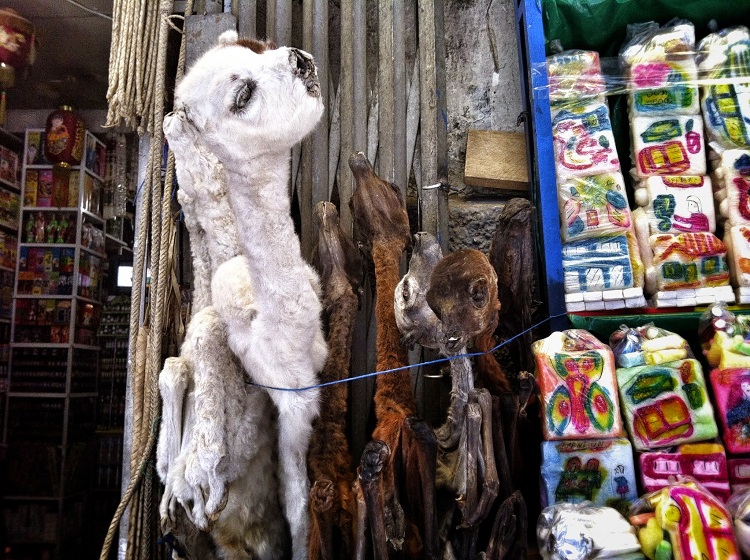
Around the corner from Rodriguez Market, we were lead to the part of the city where ancient Aymaran beliefs are still practiced.
For those suffering an ailment, searching for wealth or looking to exact revenge on a cheating partner, La Paz’s Mercado de Hechecería , is the place to go for a variety of potions, medicinal plants, spells and spiritual advice.
One of the most peculiar items I came across while perusing the stalls were the dried llama fetuses. According to our guide, Bolivian families make a cha’lla (offering) to Pachamama by burying a llama fetus under the foundations of their new homes for protection, health, happiness and good luck.
The Witches Market is certainly an entertaining sight for travelers, however it’s important to remember that the market is a serious and sacred business to the people who work there. Picking up items willy-nilly and taking photos without permission is not appreciated by the Witch Doctors, who may in turn curse you!
San Francisco Church and Plaza
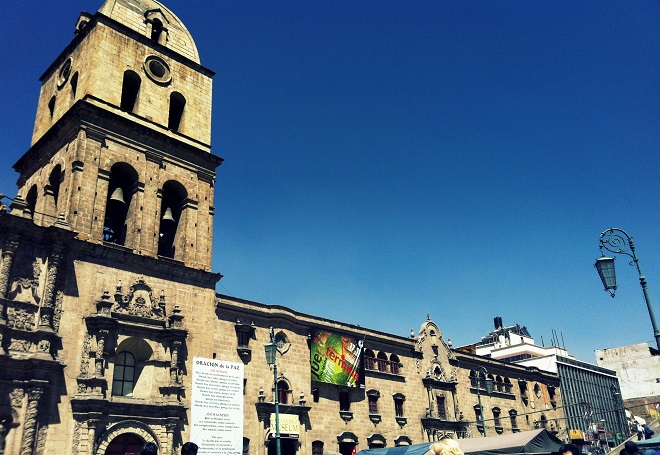
Next we visited one of La Paz’s most important and historical landmarks, the San Franciso Church .
The beautifully decorated church, admired for its intricately carved facade and blending of catholic and native art, was built entirely by indigenous Aymara workers in the middle of the 18th century.
The church’s outer walls, built in the baroque-mestizo style, feature carvings of indigenous symbols, such as snakes, dragons, tropical birds and masked figures. A contemporary statue of rock columns in the upper section of San Francisco Plaza is intended to honour the Tiwanaku , Inca and modern cultures of Bolivia.
San Francisco church is a focal point of La Paz and therefor a prime location for protests, demonstrations, and organised events.
Mercado Lanza
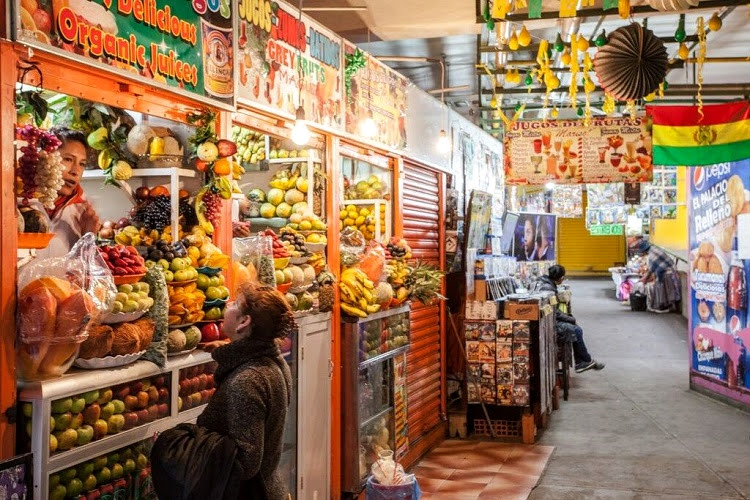
On our way to Plaza Murillo we walked through a passage-way housing a variety of hole-in-the -wall restaurants selling traditional Bolivian food and delicious fruit juices.
Food sovereignty is important in Bolivia with smaller local eateries thriving over big franchises due to their ability to serve satisfying, healthy, home-cooked food at affordable prices.
I was aghast to learn that McDonald’s had to close their doors in La Paz due to their inability to attract a customer base. It’s hard to think of other places in the world where a nation’s people prefer to buy their burgers from a local vendor than the ‘golden arches’!
Plaza Murrillo
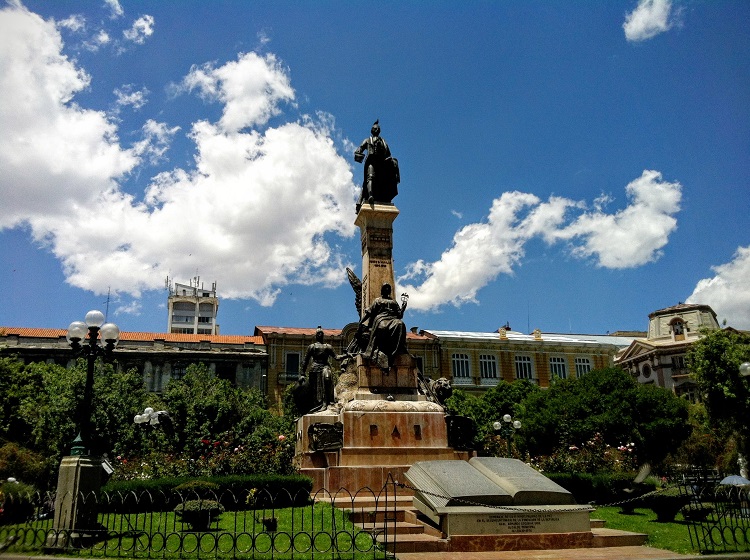
Arriving in the central plaza of the city, we all took a seat on the steps facing the Presidential Palace and the Cathedral of La Paz .
In hushed tones so as not to ‘upset’ nearby locals, our guide proceeded to give us a brief overview of Bolivia’s dramatic political history.
We learned that Bolivia’s political past has been quite brutal with presidents assassinated at an alarming rate. A recent example of Bolivia’s political violence was in 1946 when president Villarroel was set upon by group of enraged rebels who threw him off a balcony and proceeded to hang him from a lamppost.
Thankfully, politics in Bolivia now seems to be free of violence, The current president, Evo Morale, looks to be doing good things for the country and is popular among the indigenous communities.
That being said, president Morales has had his fair share of political mishap, making wild claims such as ‘eating too much chicken will make you gay’, and ‘drinking too much coca cola will turn you bald’. Fortunately, he acknowledged the absurdity of these statements and apologized to the groups of people he offended.
Hotel Presidente
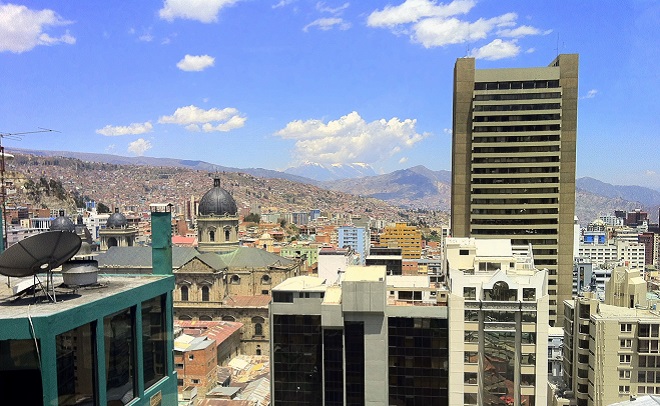
Our final stop on the walking tour was the 17th floor of Hotel Presidente.
Set against a backdrop of massive mountains and endless blue skies, La Paz became more than just a maze of urban dwellings. The bustling city, beautiful in its own unique way, features stunning architecture, historic buildings and colourful surrounds. You just have to know where to look.
If the view wasn’t enough, we were offered the opportunity to abseil down the outside of the hotel with Urban Rush . Satisfied with the walking part of the tour, I politely declined the invitation and wandered back through the narrow streets with a new appreciation for this incredibly fascinating city.
Note: Tours now finish at Olivers Tavern where you can try a local drink and get help booking anything you would like to do in Bolivia!
Having two friendly, passionate and knowledgeable guides show me around La Paz was a truly memorable experience. Most of all, I really appreciated being able to see the sights from a local’s perspective in a fun, safe and entertaining setting. Highly recommended for those visiting La Paz for the first time!
The Details

Starting Point: Plaza San Pedro
Cost: 20 Bs / $3 US per person
Tour Length: Approx. 2 1/2 hours
Distance: About 2.5km with plenty of stops along the way
Leaving: 11am and 2pm daily
Guides: English and Spanish speaking
What To Bring: Hat, sunscreen, money, bottle of water, camera, and comfortable walking shoes
YOU MAY LIKE

Let's Discuss...
I don’t find La Paz “congested and chaotic”. To me, it has the feeling of a medium-sized town.
And it definitely isn’t “sprawling”. Where would it sprawl to? It’s surrounded by mountains.
It’s always funny when people mention that there is no McDonalds in Bolivia, but fail to notice that Coca Cola is the national drink. But nice talk about “food sovereignty”.
The scandals and lies of Evo Morales are a bit more than a “mishap”, too. There is a reason he lost the last referendum, even among his own traditional constituencies.
Hey Andreas. Another interesting fact I learnt on the walking tour was that cash-strapped San Pedro Prison was once able to procure extra cash by working with Coca-Cola. The soft drink company supplied the prison with tables, chairs and umbrellas in return for the exclusive right to advertise and sell its product line within the prison.
Add a Comment
Don\'t notify me of new comments Notify me of replies to my comments Notify me of all new comments
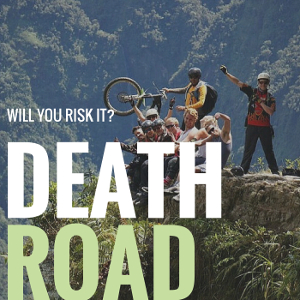
Best Of Bolivia

- Death Road Bike Tour
- Skiing and Snowboarding Tour
- Abseiling And Rap Jumping
- Sandboarding And Wildlife Tour
- Ride And River Tour
- Cholita Wrestling
- La Paz Guided Walking Tour
Popular Posts
- 18 Incredible (But Cheap) Things To Do In La Paz
- Traveling Between Uyuni And La Paz
- Mi Teleferico: La Paz’s Cable Car System
- Bolivia’s Death Road: Would You Risk it?
- Top 10 Places to Party In La Paz
Recent Posts
- Parque cretacico sucre bolivia: A popular tourist attraction
- Traditional food in La Paz Bolivia: A culinary attraction
- What to do in La Paz in one day: walkthrough unique spots
- Colombia Hop: Hopping Around South America
Recent Comments
- Arnold Gall on Mi Teleferico: La Paz’s Cable Car System
- Vitor on Running in La Paz
- Kevin Smith on Mi Teleferico: La Paz’s Cable Car System
- Aurora on Alasitas Festival
- September 2020
- August 2020
- February 2017
- August 2016
- February 2016
- January 2015
- December 2014
- November 2014
- October 2014
- August 2014
- Bars & Clubs
- Movies & Shows
- Museums & Churches
- Parks & Plazas
- See & Do
- Sport & Adventure
- Traditions & Holidays
- Uncategorized
- Entries feed
- Comments feed
- WordPress.org
- About La Paz Life
- Work With Us
- Bolivianlife.com
- Sucrelife.com
Get ready to discover
LA PAZ in 2021
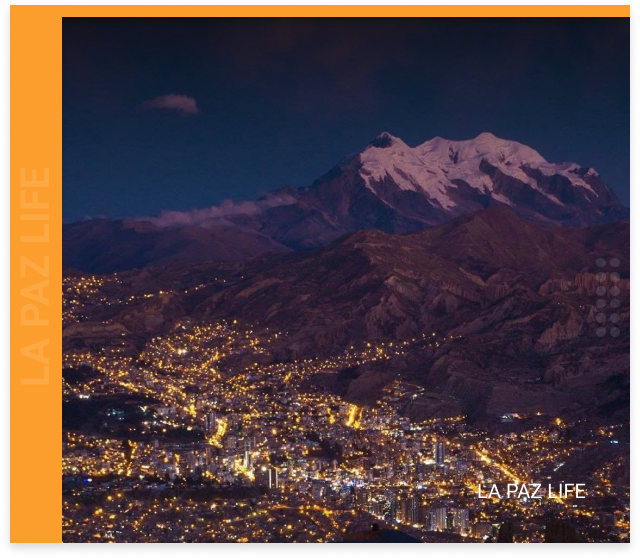
Sign up to stay up to date with all tips and recommendations for 2021 travel
- Travel Ideas
A look inside San Pedro prison, where inmates guard each other and visitors are no longer welcome
DRUG dealers mingle freely, prostitutes come and go, and inmates deal out their own justice. This is the world’s strangest prison.

Inside state’s wild new resort plan

Irwin’s surprising fave Aussie holiday spot

‘Begun to stink’: Mt Everest’s gross problem
IN THE heart of the Bolivian city of La Paz, in a prison unlike any other, inmates live by their own rules.
Drug dealers mingle freely. Prostitutes come and go and cocaine is produced and trafficked.
Guards take bribes and inmates deal out self-styled justice. The results are often fatal.
The prisoners are fed two meals a day and forced to work for a third. Cells are not free, either. If an inmate cannot afford a cell, it’s life “on the streets” inside, which is far more dangerous than life on the streets outside.
Inmates who can afford a cell live with their wives and children, but that creates obvious problems.
In 2013, it was alleged a 12-year-old girl fell pregnant after being raped by her father and several other men.
The fallout was bad for Bolivia and the government announced the facility’s imminent closure . A new jail would be built outside the city and prisoners would be relocated.
Almost three years later, San Pedro prison remains open but it won’t stay open for long.
I decided to take a look for myself. After bribing the guards, my camera was confiscated. The things I saw will stay in my memory forever.
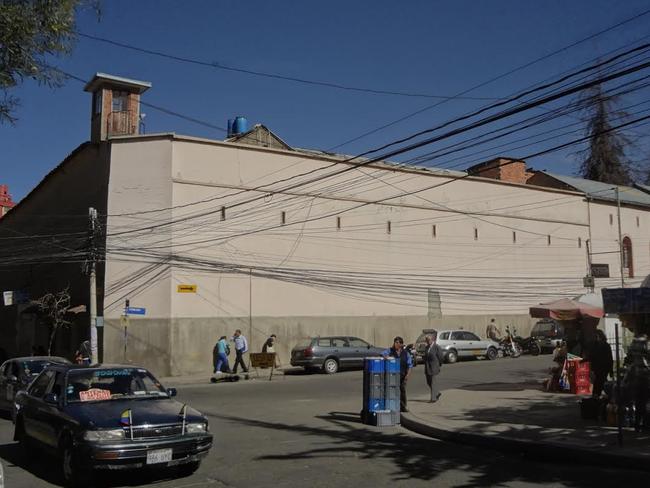
A CITY BEHIND HIGH WALLS
Originally built to accommodate 600 prisoners, San Pedro holds over 2000 inmates and their families at any one time.
San Pedro inmates live within the five, four and three star accommodation sections, or “on the streets”, and must rent or purchase their own cells for up to $1100 each, in addition to a one-off “entry” cost of about $270.
For prisoners in one of the poorest countries in South America, these are often unachievable savings.
To pay for their safety, prisoners carry out work as kitchen hands, cooks, cleaners, carpenters, painters and convenience store owners. “Street” vendors even sell homemade foods.
Where it is said the most money is made is in the production of illicit drugs — specifically cocaine.
The majority of inmates in San Pedro have been imprisoned for their roles in the manufacturing and distribution of cocaine.
With no law enforcement patrolling the interior and guards accepting bribes to access supplies, knowledge of producing and distributing cocaine can lead to an attractive, high source of income.
Inside the facility, some prisoners confirm cocaine is produced by inmates and smuggled out by visitors and their family members.
Despite this, mothers and children regard their living situation as relatively safe.
When touring the facility, prisoners openly discuss the zero tolerance attitude toward violence or mistreatment of women and children.
However, a lack of official enforcement and monitoring makes safety impossible to ensure.

MY TOUR BEGINS
Made infamous by the release of the book Marching Powder in 2003, the prison began to attract more attention and foot traffic from curious tourists seeking a closer look.
Scribed by Australian Rusty Young, who bribed his way into voluntarily living inside the facility for three months, the book details the experiences of imprisoned English drug trafficker, Thomas McFadden.
As a foreign, English-speaking prisoner, McFadden faced terrifying grief.
However, his situation also led him to his own revenue stream. He became a tour guide at the facility, accommodating curious internationals.
On the day I visited, a group of tourists were led through the exterior gates to an office of the most senior guard on duty, an area between the outer wall and the prison yard.
Left alone for just enough time to second guess our decision to enter, an intimidating and confusing conversation was had between the visitors and the guard.
The group was then introduced to the tour guide; a prisoner fluent in English, convicted for trafficking cocaine out of Bolivia.
After a reassuring speech about security and the “once in a lifetime” opportunity, we gathered to privately discuss whether the prisoner could be trusted.
My wallet and camera were confiscated on the way in, something I now realise was for my own protection.
My arm was stamped on the way in. The stamp was the only thing distinguishing me from the inmates. Walking in, we were met with cheers and jeers.
Money changed hands quickly. With each transaction we held our breath, hoping the guide had enough cash to pay for our protection.
Like many other Bolivian buildings, San Pedro prison is in a run-down state, however inmates still take pride in the presentation of their homes and living quarters.
Prisoners have access to all offerings in their own section, as well as the opportunity to use communal services and businesses in common areas of the jail, such as food stalls, restaurants, convenience stores, massage therapists and an on-site brothel, run by visiting prostitutes who are believed to pay guards a fee to enter.
Despite many illegitimate practices taking place inside, prisoners also run good-hearted health and spiritual programs for those in want or need.
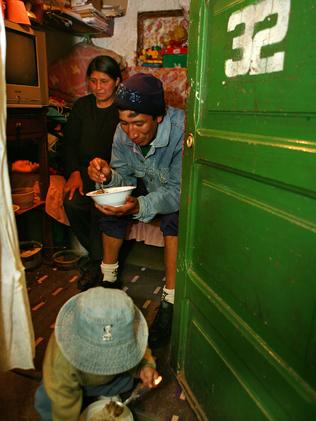
There’s a drug rehabilitation facility and chapels in each section.
Inmates openly declare themselves as ongoing drug users and to avoid temptations and quit, prisoners spend their days inside the restricted quarters of the rehabilitation area.
Other prisoners use faith to help them serve their time behind bars, attending services, joining groups and becoming involved within a variety of religious programs.
In Marching Powder , Young describes a scene where accused child rapists are murdered in a frenzy. Their bodies are dumped in a concrete hole known as the “swimming pool”.
Violence exists, but we didn’t see it.
The prisoners we encountered were calm and polite and seemed as interested in the tourists as the tourists were in them.
Many inmates greeted the group with “hola” or “hello”, followed by a giggle.
Some offered souvenirs such as bracelets or a memento of the experience.
One prisoner gifted the group a portrait drawing of each visitor, signed by himself as a San Pedro prisoner.
Guests were given the impression the visit was valued, more so than just financially, and that inmates legitimately cared for our wellbeing.
RAISING CHILDREN BEHIND BARS
The education of kids in San Pedro is taken seriously.
Those living inside are schooled at the nearest facility within a few hundred metres of the jail, and are walked to and from school each day by prison guards.
Many Bolivians are unhappy children are being brought up alongside criminals and argue that a youth spent behind bars does not provide kids with normal social skills or an appropriate environment to learn.
Inmates speak of the children being ridiculed and often becoming bullies at their school.
Soon, wives and children won’t live with their convicted husbands.
Following the controversy over the 2013 attack, the government announced the building will be acquired by the Ministry of Economy and Public Finance of Bolivia.
A new prison will be built outside the city and all prisoners will be transferred.
The new facility will bring an end to La Paz’s infamous San Pedro prison.
Illegal tours have ended, according to locals I spoke with recently. The jail continues to operate, for the time being, but the doors have closed to the public forever.

Another Australian capital city is poised to offer surfers rolling artificial waves, with a council considering a multi-million dollar development application.
Robert Irwin is a Queenslander through and through, so his favourite Aussie holiday spot may surprise you.
There is 3000kg of human poo estimated to be on Mount Everest and it’s causing a foul stench, with climbers now forced to collect faeces.
TRAVEL BLOG

Prison Breaks: The Inside Story
Whilst millions flock to historic prisons like Alcatraz and S-21 every year, Sasha Arms reports on one of the 21st Century’s most bewildering and controversial travel trends: visiting inmates at high security foreign jails.
Defunct prisons have long made for unlikely success stories in the world of tourism: sites like Alcatraz , Robben Island in Cape Town and S-21 in Cambodia have become pilgrimage points for curious travellers, with a pull almost as powerful as the Golden Gate Bridge, Table Mountain and Ankor Watt, their traditional counterparts. Something in our human nature draws us to ponder the wretched plight of the prisoners who once occupied the empty cells, chalking up the years on bare stone walls, often enduring cold, hunger, beatings, torture and fear of death.

Wrestling the the ghosts of the past is one thing, but who can seriously imagine themselves visiting a fully functioning modern day prison abroad? Bribing your way in as a tourist and coming face to face with thieves, drug dealers and violent criminals? Sound outlandish? Well incredible or not ‘prison tourism’ has become one of the most bizarre travel trends to emerge on the backpacker trail in the 21st century…
San Pedro Prison in Bolivia may not be the first prison in the world to admit tourists, but it’s becoming one of the most renowned after a British drug-trafficker was imprisoned there in the late 90s. Thomas McFadden was shocked when he discovered how things really worked behind closed doors in the Latin American jail – notably that prisoners have to buy their own cells, rapists sent to the prison are apparently routinely murdered by fellow inmates, and that some of the purest cocaine in the world comes from inside the prison walls.

McFadden however found a way to use the widespread corruption to his advantage, and hatched a scheme to raise the $5,000 bribe money he needed to pay off his prison sentence. The plan? To take travellers on tours of the prison. Backpackers would pay McFadden a fee for the tour, and he would pay the guards a bribe to let them in, which generated enough money for him to survive and eventually get out. McFadden has long since left San Pedro (in 2000), but sensing the opportunity to carve a prison career for themselves (everyone needs one in San Pedro to pay their way), other inmates took over the prison tour trade, cashing in on the jail’s cult status that has followed in McFadden’s wake.
Spectators musing on the trend may wonder what possesses people to visit prisons. Is it a visceral strand of so-called ‘ dark tourism ‘, one which compels tourists to experience humanity being punished first-hand? There are some very mixed opinions about the matter, but backpackers passing through La Paz can’t escape the possibility of visiting San Pedro, such are the tours’ fame – they have even been listed in the Lonely Planet guide. The thought of such a visit repels some, who say that backpackers only do it for the satisfaction of being able to say they’ve been inside a Latin American prison – the travel kudos if you will. Whilst stories of visitors being robbed and getting stuck inside are enough to dissuade others. For many, however, it’s quite simply an opportunity not to be missed.

Erin Pelquest-Hunt , who had read Marching Powder by Rusty Young (the story of Thomas McFadden’s experience as a prisoner), found herself in the latter camp of people while travelling in Bolivia. “Most of the travellers I met in La Paz had been there or were planning on it. It had a bit of a cult following and didn’t sound unsafe at all,” she says. “One of the guys I had dinner with showed me this bracelet made by a prisoner, and I thought something like that would be a great souvenir to accompany an amazing story.”
Although Erin admitted that she was driven by morbid fascination as much as anything, it was something she ultimately couldn’t pass up: “Had I thought about it a bit more I may have decided against going, but travelling is all about new experiences. It sounded all a bit unbelievable, I mean everyone’s heard about prison tours but never in one that’s still operating, especially not one where everyone has jobs. It sounded so unique and something I would regret for the rest of my life if I passed it up, so there were no two ways about it. I had to go!”

Most visitors agree that it’s hard to tell that San Pedro is even a jail from the outside. Set next to a square in town, the only giveaway that San Pedro is a prison are a couple of guards and some watchtowers. Hearsay tells travellers to loiter in the square until someone approaches to invite them into the prison. Erin’s first impressions of the jail were of nothing spectacular – the guards couldn’t have cared less about them going in, prisoners were not wearing uniforms and the inmates seemed to just be sitting around, chilling out. “It really looked nothing like a prison at all, just a dirty, smelly community… There was even advertising for Coca-Cola.” Incredibly, Coca Cola provides the cash-strapped prison with tables, chairs and umbrellas in return for the exclusive right to advertise and sell its product line (proving you really can’t escape commercialism).
A typical San Pedro tour consists of a guide (usually a member of the strongest gang at the time) taking tourists to the different cell blocks, inside cells, to the cafés, bars, and to the artisans’ stalls for those much sought-after souvenirs. It’s generally a look around the prison in its daily normality. Including the cocaine production. “Every now and then an inmate would have a great big bag of coke sitting there in plain view,” Erin remembers. “I felt like telling some of them to hide it…that they could be sent to prison for that!”

Another ‘unique’ aspect of the prison is that inmates’ wives and children are also allowed to live there, and it’s not always easy for visitors to see children growing up in such an environment. And however ‘normal’ or non-threatening the prison may appear on the surface, it’s important to remember that that is not the case. You only have to read Marching Powder to remember the realities of what goes on inside a Latin American prison. Erin is also very clear about that: “While I felt safe being escorted down dark alleys, you certainly wouldn’t want to be there at night. You could scream bloody murder and no-one would hear.” She goes on to say that “it all felt very safe, and it was only the stories we were told about what went on at night that made us shiver from something other than the cold.”
Certainly the most famous, nonetheless the San Pedro story is not as unique as it sounds: word is starting to get out about other prison ‘experiences’ across the globe. Bang Kwang maximum security prison is just one institution in Thailand making a name for itself among travellers as a ‘must see’ on the backpacker trail (others are Klong Prem and Samut Prakan Central Prison). It’s home to the Thai death row, criminals in for the most serious offences including rape and murder…and generally a handful of Western prisoners at any one time. The trend of visiting Thai prisons started when the families of Western prisoners put up notices in hostels and guest houses, urging passing travellers to go and visit their loved ones because they couldn’t be there themselves all the time. Since then it has become almost ‘fashionable’ amongst backpackers to visit the convicts, and offer some company and goodwill to those with little left to hope for, deservedly or not.

Deciding whether or not to take advantage of a country’s corruption and visit a prison such as San Pedro seems to be more of a moral dilemma than a decision of free-will. The question is that of motivation. You could visit to inform yourself of a way of life and state of affairs, or to call-on lonely, scared prisoners who are far from home and desperate for friendly faces. Visiting San Pedro in particular helps to fund the inside economy. As everyone has to work to feed themselves, their families and pay their rent, tourists can help them survive on the inside – which is a basic human right. These are all very noble reasons. But how many prison tourists hide behind such a mentality, when all they really want to do is to tell their friends back at home how they visited a prison – an act that was potentially riddled with danger – and therefore all the more interesting to talk about in the pub? It’s difficult to know, and who would really admit to that anyway?
For the full account of the crazy sub-society of San Pedro Prison in Bolivia then obviously Marching Powder by Rusty Young is your main source, revealing everything from the cells so luxurious they resemble five-star hotel suites to the cocaine-addicted pets of the crack head inmates. Youtube turns up some interesting footage too, here and here , and the BBC chronicles San Pedro in this fascinating photo journal . For more on prison life in Thailand, your essential tomb is The Angel of Bang Kwang Prison , the account of Australian Susan Aldous who has devoted much of her life to helping the inmates living in the ironically dubbed ‘Bangkok Hilton’.
Other Prison Stays & Experiences

If visiting (supposedly) high-security prisons isn’t on your travel agenda, there’s another much milder alternative to the prison tourism trend to throw into the mix. Jail houses such as Sainte-Anne in Avignon, France Malmaison Oxford and Hotel Katayanokka in Helsinki have all been converted into luxury hotels. At the latter, despite the wide range of mod-cons (no pun intended), all drinks are served in tin cups, guests are labelled with ‘guilty’ stickers and even given iron balls with chains to give them a small taste of what it was like to be an inmate.
For arguably the most bizarre strand of the prison tourism trend, look no further than Louisiana State Penitentiary. Thousands of law-abiding citizens flock to this jail every year for the Angola Prison Rodeo , to watch prisoners compete at everything from the saddle bronc to steer wrestling…
Enjoyed this? Please share...
Current version updated on August 20th, 2013
First published on May 3rd, 2010
Posted in Special Feature , Trend with destination tags Bolivia , La Paz , Thailand
Your email address will not be published. Required fields are marked *
Your Name *
Your Email *
Your website
Save my name, email, and website in this browser for the next time I comment.
Please subscribe me to the Urban Travel Bulletin!
APRIL SALE: Book now and get up to 60% off!
Bolivia Tours & Trips from La Paz
Find your perfect adventure! We have 45 tours of Bolivia that start in La Paz, Bolivia. The most popular month is June, and tour lengths range between 3 and 22 days.
45 Bolivia tour packages from La Paz with 56 reviews
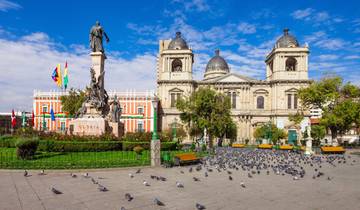
- Coach / Bus
Bolivian Magic (6 Days)
- €100 deposit on some dates Some departure dates offer you the chance to book this tour with a lower deposit.

- In-depth Cultural
Bolivia Discovery
The journey to and through the salt flats was spectacular as expected! The accommodation and meals at the Planetarian salt hotel were really lovely. Our tour guide was great fun and knowledgeable. Although it was good to visit Sucre I was disappointed with the latter half of the tour as there were no activities included and once we returned to La Paz on the penultimate afternoon our guide we were left to our own devices again until our departure on the final day. For that reason the tour was actually 10 days rather than 11 and not particularly good value for money (if your purchased for full cost).

- Christmas & New Year
From La Paz, Andean Magnificence to Uyuni Salt Flats: A 12-Day Journey Through Bolivia
Thanks to everyone involved...especially to Erika and Andres! Also thanks to my guides up the shield volcano. Thanks also to all the people who met me at ferries and shuttled me to hotels! Things went well and was the right balance of activity and rest time. The highlight for me was the snorkeling. While I have been to better reefs in the world (this was not a reef, but the lava rock shore), the diversity of marine life and closeness to nature and to its creatures was the best I have ever experienced!
- Book With Flexibility This operator allows you to rebook your dates or tours with them for free, waiving change fees.

Bolivia Highlights
Amazing tour in Bolivia with wonderful landscape and beautiful cities. As for the itinerary I'd suggest 1 more night in Potosi'.

Bolivia Adventure – 6 Days La Paz Uyuni Salt Flat Pulacayo Tomave

Tailor-Made 10-Day Best Bolivia Tour, Daily Departure & Private Guide

The Best of Bolivia: La Paz, Tiwanacu, Uyuni Flats & All Lagoons - 5 Days
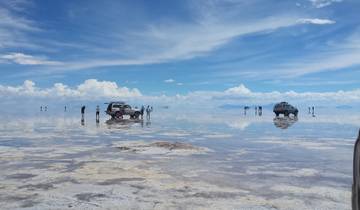
Tailor-Made 8 Days Bolivia Trip with Daily Departure & Private Guide
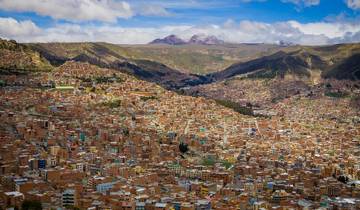
Uyuni Salt Flats and Potosi
We had a very good guide and a very safe driver
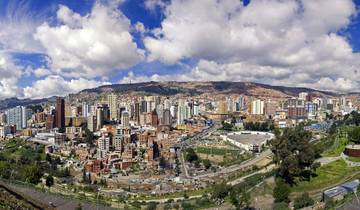
Highlights of Bolivia National Geographic Journeys
Excellent tour. So much to see and do. Highly recommended
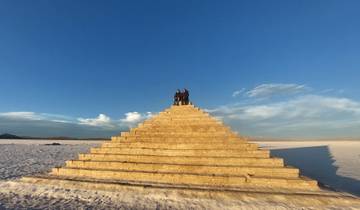
Deep Bolivia
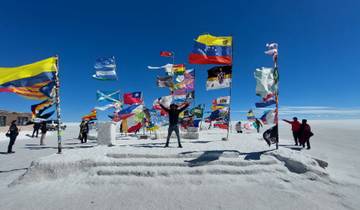
Magic Bolivia
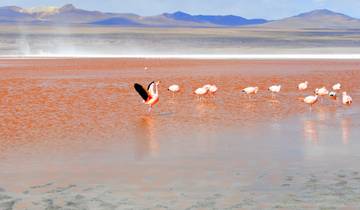
Tailor-Made 7-Day Bolivia Adventure, Daily Departure & Private Guide

- Hiking & Trekking
12 Days Bolivia, Andes Hiking and Amazon Expedition
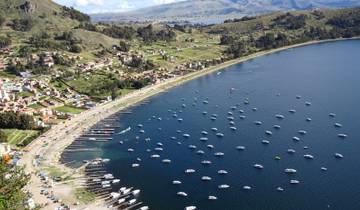
La Paz and Titicaca Lake Starter Package (6 Days/ 5 Nights)
What people love about bolivia tours from la paz.
Well organized, a lot of opportunities for extra trips or activities, excellent tour leader helpful and enthusiastic with full knowledge of the subject. Average to good accomodation, but still excellent value for money. Well planned 3 days Salar de Uyuni trip. I would recommend to GA to add more days to the program of the tour for visiting other interesting places of this beautiful country
This was an absolutely fabulous tour for someone on a budget. I was a woman traveling alone and felt perfectly safe too. I really enjoyed all the tours and had no problems except one small miscommunication. We went I On a hike to a volcano and I was told it was 3 miles, but it ended up being 10 miles. I had broken my ankle about 6 months before so there were a few problems- but I made it and it was a wonderful hike. Overall completely enjoyed the experience. I would definitely recommend to others.
The tour was excellent including our guide Marisol Maydana She made me feel safe , gave good information daily on what we saw , always looked after us well like a good friend. I enjoyed the bus rides as got to see the countryside side of Boliva accommodation was comfortable. All the places we went were good. I would suggest in future maybe include dates for the LaPaz Carnival. I was lucky and although didn’t know about LaPaz carnival I was in LaPaz 5 days before carnival started so got to enjoy it , I think future customers would also. Thank you. My first trip with Tour Radar was a success. Kathryn Fink
Tours starting from La Paz
- La Paz to La Paz tours (32)
- Family from La Paz (28)
- Private from La Paz (22)
- Explorer from La Paz (21)
- In-depth Cultural from La Paz (18)
- Self-Guided from La Paz (9)
- Active from La Paz (9)

COMMENTS
Right in the heart of La Paz' middle class San Pedro neighborhood lies one of the world's most notorious prisons. Cárcel de San Pedro (San Pedro Prison) reached international fame in 2003 when Australian law graduate Rusty Young released his first novel, Marching Powder: A True Story of Friendship, Cocaine, and South America's Strangest Jail.
Prison tours, though technically illegal, were a popular activity among backpackers in La Paz, with up to 50 tours occurring daily. Prison guards accepted bribes as high as 400 Bs ($57 US), marking tourists' arms with a number upon entry so they could be identified and released at the culmination of the tour.
Touring San Pedro Prison is to enter a brutal surreal circus. Despite once being a nunnery of - I assume, well-behaved, Catholic virgins, the complex now houses 1300 of the baddest bad boys. Resembling a shanty market, but with high walls and deep courtyards, survival in San Pedro depends on your cash and insider status.
Steve Madgwick. In the '90s, it was quite common for backpackers to take an unofficial tour of La Paz's notorious San Pedro prison. Alamy. A quaking hand unclenches to reveal a rock of base ...
San Pedro prison. Coordinates: 16°30′11″S 68°08′04″W. The main entrance of San Pedro prison in 2024. San Pedro prison or El penal de San Pedro (Saint Peter's Prison) is the largest prison in La Paz, Bolivia and is renowned for being a society within itself. Significantly different from most correctional facilities, inmates at San ...
The San Pedro prison tour in La Paz, Bolivia is illegal and always has been. Nonetheless, tens of thousands of tourists have taken this tour. Thanks to the irresponsible actions of prison staff and foreigners alike, in March 2009 there was a mutiny at the San Pedro Prison which resulted in injured inmates and visiting family members, as well as 150 children who live at the prison with their ...
Walking tour of La Paz, Bolivia. Stop by the Witches' Market, known for selling traditional herbs associated with witchcraft. Visit one of the world's most bizarre correctional facilities, San Pedro prison. Explore the central plaza of La Paz, Plaza Murillo. Stroll down a market's potato-sack-lined street where cholitas sit at their booths.
See vibrant markets, colonial architecture and mountain views on a sightseeing tour of La Paz with a small group that includes Plaza Murillo, San Pedro Prison and the Witches' Market. Hear Bolivia's rich history as you follow your guide through the heart of the city, and learn how inmates have created a parallel city in Bolivia's most famous prison. Sample local cuisine and in a ...
Experience the unique culture of La Paz while hopping from market to market on this walking tour through the city. Explore Plaza Murillo, and stop by a few brightly colored markets. See streets lined with more kinds of potatoes than you even knew existed, and make a visit to the notorious San Pedro prison.
San Pedro penitentiary is the largest prison in Bolivia and it is located in the heart of La Paz. . It was built to accomodate 500 inmates but now about 2.500 inmates and 500 of their wives and children live inside the jail. The structure is owned by the Bolivian state and is guarded by uniformed officers of the Bolivian police but the internal ...
The thriving sense of community at San Pedro prison in La Paz, Bolivia, belies the dangers to which inmate families are exposed. ... Obrajes women-only prison, in southern La Paz, is a successful model with strong discipline, little violence and strong cohesion between inmates. ... At the peak of McFadden's tours, up to 70 tourists would ...
Step into 'Heartbeats of La Paz', a journey through the city's vibrant pulse. Discover the enigmatic San Pedro Prison, the bustling Rodriguez Market, and the mystical Witches Market. Marvel at the historic San Francisco Church, stroll down the lively Calle Comercio and feel the grandeur of Plaza Murillo. Enjoy panoramic city views from Killi ...
June 16, 2014, 8:40am. The San Martín section of Bolivia's San Pedro prison. Photo by Niels Van Iperen. Being imprisoned for drug smuggling usually means taking a little break from being a ...
San Pedro Prison, in La Paz, Bolivia, is a self-governing community of criminals. ... There are still posts about tours of San Pedro jail online, but officially the place has been off-limits to ...
Until the 1990's, outside of Bolivia at least, little was known about the ongoings in San Pedro and travellers to La Paz came and went, most likely without even knowing the place existed. That all changed when British-Tanzanian Thomas Mcfadden started offering tours of the prison after he was incarcerated for drug trafficking in 1996.
San Pedro Prison, Bolivia. Credit: Danielle Pereira. ... In Marching Powder, McFadden earned money by leading guided tours through the prison. If the visitors paid enough, they were also allowed to stay the night and indulge in the jail's famous "produce". ... If you're in a La Paz hostel talking about going to San Pedro, someone will ...
However, for Liverpudlian Thomas McFadden — who was apprehended at La Paz airport in 1996 with five kilos of cocaine in his suitcase — the four-and-a-half years spent at Bolivia's infamous ...
After a friendly introduction from our two guides, and a quick meet & greet, we set off on our walking tour of La Paz. San Pedro Prison. Located off the tranquil Plaza San Pedro, we were shocked to learn that some Bolivia's most hardened criminals lived only meters away in one of the world's most corrupt prisons.
18/11/2008 FEATURES: LA PAZ, BOLIVIA - MARCH 20: A general view of the crowded courtyard inside the San Pedro Prison for men on March 20, 2007 in the heart of La Paz, Bolivia.
Report on visiting San Pedro prison in La Paz Bolivia and Bang Kwang in Bangkok Thailand. Plus more prison tours of Alcatraz, Robben Island, S-21. URBAN TRAVEL BLOG. CITY GUIDES. ... There are some very mixed opinions about the matter, but backpackers passing through La Paz can't escape the possibility of visiting San Pedro, such are the ...
Family from La Paz (27) Private from La Paz (21) Explorer from La Paz (20) In-depth Cultural from La Paz (18) Self-Guided from La Paz (10) Active from La Paz (10) We have 44 Bolivia tours from La Paz with 56 reviews. The most popular departure month is June. Book now and save with TourRadar.com!